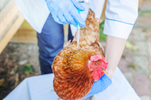
THE VACCINATION DEBATE: WHAT THEY DON’T TELL YOU
, by Majella Gee, 28 min reading time

, by Majella Gee, 28 min reading time
Understanding poultry vaccines, what’s inside them, and why many backyard keepers choose a different path.
When you buy day-old chicks from a hatchery, the vaccination question is usually asked quickly, almost like a tick-box:
“Do you want them vaccinated?”
Most people say yes because it sounds like the safest or most responsible choice — even though very few are ever told what the vaccine contains, why it’s given, or whether backyard flocks actually need it.
This article isn’t here to tell you what to do.
It’s here to give you the information that rarely gets shared, so you can make an informed decision that suits your flock, your environment, and your values.

What Poultry Vaccinations Actually Are
The most common poultry vaccines offered for backyard chicks are:
These vaccines weren’t designed for backyard coops.
They were created for large-scale commercial farming, where:
In those environments, vaccines play a major role in reducing economic loss.
But your backyard coop?
Fresh air, sunlight, clean litter, space, and far lower disease pressure.
Very different scenario.
Why Hatcheries Promote Vaccination
Hatcheries recommend vaccines because:
This doesn’t mean vaccination is wrong — it just means their recommendation is based on commercial logic, not the realities of a small backyard flock.

What’s Inside Poultry Vaccines?
Based on publicly available manufacturer vaccine inserts.
Many keepers are surprised to learn that poultry vaccines contain more than just the virus they intend to protect against. Because inserts are rarely provided at sale, most owners never see the full ingredient list.
Here’s a transparent look at typical components.
Active Component
Stabilisers
Used to keep the vaccine effective during storage and transport, such as:
These help the vaccine survive handling and temperature changes.
Adjuvants
Added to strengthen the immune response.
Common examples include:
Antibiotic Residues
Used during production to prevent bacterial contamination of viral cultures.
These may include:
These are not added for the bird — they are part of the manufacturing process.
Preservatives
Depending on the vaccine type, preservatives may include:
Formaldehyde / Formalin (trace residuals)
Used to inactivate viruses during manufacturing.
Only very small residual amounts remain in the final product.
Formaldehyde is classified as a carcinogen in high-dose, long-term industrial exposure.
Because of this classification, many natural and organic keepers prefer to avoid products containing even trace amounts, especially when alternatives exist.
Phenol or phenolic compounds
Used as preservatives in some inactivated vaccines.
Thimerosal (mercury-based preservative)
Rare today, but still listed on some older inserts or particular formulations.
These preservatives are standard in vaccine manufacturing — not hidden, but not openly discussed either.
The lack of transparency is often what frustrates small-scale keepers the most.

Why Many Organic, Natural, and Small-Scale Keepers Choose Not to Vaccinate
These are common viewpoints among people who prefer to raise chickens naturally. They are not claims — simply the reasons keepers give when explaining their choice.
Vaccines were designed for commercial flocks
Backyard flocks don’t face the same crowding or stress-related disease risk.
A preference for natural immunity
Many keepers prioritise:
With fewer birds and more space, it’s easier to support natural immune function.
Avoiding unnecessary additives
Some keepers are uncomfortable with stabilisers, adjuvants, preservatives, or antibiotic residues — even if the amounts are small.
Small flocks = more control
Backyard keepers can:
This is exactly why many don’t feel the need for pharmaceutical intervention.
Concern about “false security”
Many people assume a vaccinated bird is automatically protected, but:
Vaccination does not replace good husbandry.
Understanding What Vaccines Do — and Don’t — Do
A quick overview:
Marek’s Vaccine
Does not prevent infection or spread.
It mainly reduces symptoms.
ND/IB Vaccines
Help reduce severity, but not all strains are covered.
Coccidiosis Vaccine
Requires precise litter management to work effectively
(sometimes the opposite of what keepers normally do).
Vaccines are tools — not forcefields.

Do Backyard Chickens Actually Need Vaccination?
There is no single correct answer.
Vaccination makes sense in:
Vaccination may not be necessary in:
The difference lies in exposure risk.
A coop of six birds living their best life in the sunshine does not face the same challenges as a shed of 20,000.
How to Make an Informed Decision
Ask yourself:
When you answer these questions honestly, your choice will feel clearer — and truly yours.

Final Thoughts
You don’t need fear, pressure, or guilt.
You just need information, honesty, and transparency — the things that should have been offered to you at the beginning.
When you know:
…you can choose the approach that aligns with your flock and your philosophy.
Whatever you decide, the key is being informed.
Disclaimer
This article is for educational purposes only and does not provide medical advice.
Always consult a qualified poultry veterinarian and read official vaccine inserts before making vaccination decisions.
©Majella Gee 2025
#ChickenVaccination, #BackyardChickens, #ChickenHealth, #RaisingChickens, #HealthyHens, #ChickenCare, #PoultryCare, #NaturalChickenKeeping, #OrganicChickens, #UnvaccinatedChickens, #NaturalImmunity, #BackyardFlock, #ChookKeeper, #ChickenWellbeing, #ReadTheInsert, #InformedChickenKeeping,
#ChickenTruths, #UrbanHomestead, #ChemicalFreeChickens, #NaturalPoultry